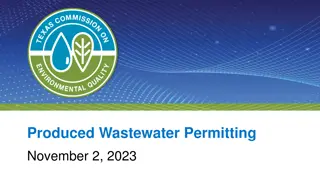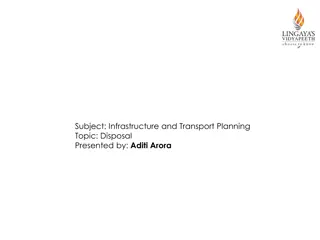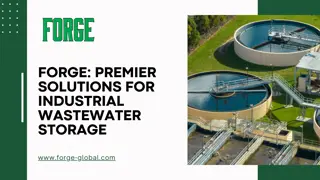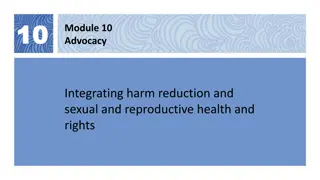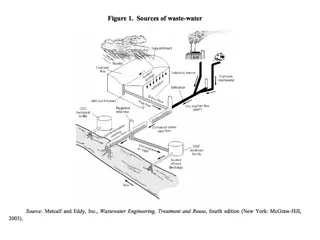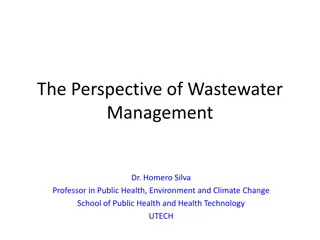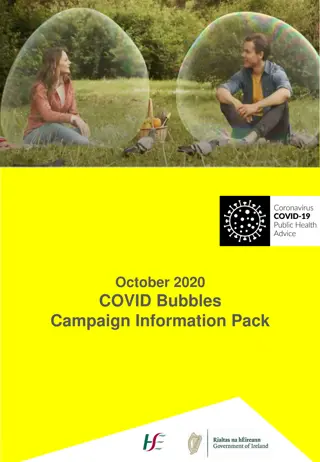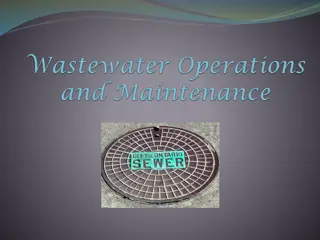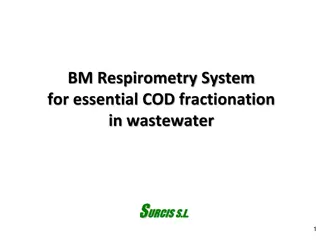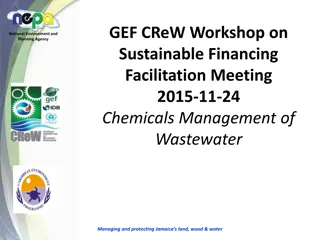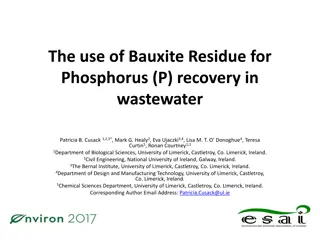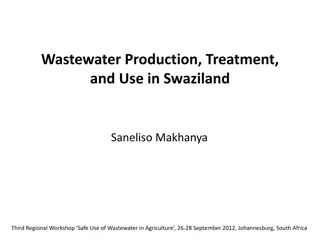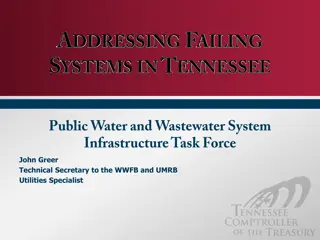Advocacy Campaign for Sustainable Wastewater Management in Texas Hill Country
An educational advocacy campaign by nonprofit organizations and citizens is promoting sustainable alternatives to direct discharge in the Texas Hill Country and Edwards Aquifer. The campaign aims to galvanize public support through strategic outreach activities, advocating for eco-friendly wastewater management practices and ultimately pushing for a statewide ban on direct stream discharge. Various engagement areas in 2018 highlight efforts to limit direct discharge permits in different locations, emphasizing the importance of protecting water quality in the region.
Download Presentation

Please find below an Image/Link to download the presentation.
The content on the website is provided AS IS for your information and personal use only. It may not be sold, licensed, or shared on other websites without obtaining consent from the author.If you encounter any issues during the download, it is possible that the publisher has removed the file from their server.
You are allowed to download the files provided on this website for personal or commercial use, subject to the condition that they are used lawfully. All files are the property of their respective owners.
The content on the website is provided AS IS for your information and personal use only. It may not be sold, licensed, or shared on other websites without obtaining consent from the author.
E N D
Presentation Transcript
About About An educational advocacy campaign of nonprofit organizations and citizens advancing sustainable alternatives to direct discharge throughout the Texas Hill Country and the Edwards Aquifer. https://www.youtube.com/watch?v=nntwFnKw0zU&t=25s or https://www.kvue.com/video/news/investigations/defenders/kvue- defenders-wastewater-in-waterways/269-8235854
Principles Principles Galvanize public support through a strategic outreach campaign that will persist for many years, beyond any single legislature. The campaign revolves around an online petition, connected to an online engagement platform. Make eco-friendly wastewater management the norm for towns and developers in the Hill Country. Ultimately pass a statewide ban on direct stream discharge of treated sewage in the contributing and recharge zones of the Edwards Aquifer. Organize a nonpartisan network of citizen activists who are informed about and involved in water quality issues affecting the aquifer.
2018 Engagement Areas 2018 Engagement Areas Dripping Springs City of Dripping Springs applied for permit to dump 1M gallons/day of treated sewage into Onion Creek. Settlement reached in July to limit their direct discharge. Liberty Hill Received permit in 2015 to dump 4M gallons/day of treated sewage into South San Gabriel River. NDS Campaign has supported local residents and coordinated media coverage to expose excessive algae problems that have occurred as a result of dumping Wimberley City of Wimberley recently chose to use Aqua Texas for sewage treatment rather than build their own plant. NDS Campaign supported local residents and environmental groups in fighting this decision. Blanco City of Blanco recently applied for permit to dump 1.6M gallons/day of treated sewage into the Blanco River. NDS Campaign has supported local residents as they organized the www.protectourblanco.org community.
2018 Engagement Areas (continued) Honey Creek Silesia Properties recently applied for permit to dump 1/2M gallons/day of treated sewage into Honey Creek/Guadalupe River. GEAA is organizing citizens and groups to contest this permit. A public meeting was held on October 17thin Springbranch to coordinate actions to protest both this and the Indian Creek permit. Indian Creek - DBT Investments L.P. recently applied for permit to dump 18,000 gallons/day of treated sewage into Indian Creek Creek/Cibolo Creek. GEAA is helping organize citizens of Bulverde and Springbranch to contest this permit. Commissioners Creek We just learned today of a new application to discharge 49,000/gallons/day into this creek in Bandera County on the Edwards Aquifer Contributing Zone. The effluent will cross the Edwards Aquifer Recharge Zone downstream.
GEAA has worked to oppose many permits to directly GEAA has worked to oppose many permits to directly discharge sewage effluent into waterways that recharge discharge sewage effluent into waterways that recharge the Edwards Aquifer the Edwards Aquifer 2007, the Belterra subdivision s application to amend their TLAP to a TPDES to discharge wastewater into Bear Creek in Hays County was opposed by the Barton Springs Edwards Aquifer Conservation District, by Hays and Travis counties, and by 95% of the municipalities within that District. Despite a recommendation from the Administrative Law Judge to stating that the WCID has not met its burden of proving that the proposed discharge under the terms of the revised Draft Permit would not cause more than a de minimis degradation of Bear Creek, Edwards Aquifer, and Barton Springs, concerning algal growth in Barton Springs Pool , Belterra s permit was granted. In their ruling, TCEQ Commissioners cited their reluctance to effect a rule change that should, in their opinion, be a taken up by the State Legislature. Ultimately, a negotiated settlement was reached that has resulted in no direct discharges to Bear Creek to date.
GEAA has worked to oppose many permits to directly discharge sewage effluent into waterways that recharge the Edwards Aquifer In 2008, The Hills of Castle Rock in Medina County applied for a permit to discharge wastewater into the San Geronimo Creek. This application was contested by GEAA, San Antonio Water Systems, the San Geronimo Valley Alliance, and individual landowners on the basis that it would harm the quality of the water of San Geronimo Creek and the Edwards Aquifer. Additionally, both the SAWS Board of Directors and the City of San Antonio cited concerns about Hills of Castle Rocks plans to discharge into the San Geronimo as among their reasons for denying water service to this subdivision on December 4, 2007. A settlement agreement between the San Geronimo Valley Alliance and Baruch Properties required the applicant to withdraw the TPDES permit and agree to land application.
GEAA has worked to oppose many permits to directly discharge sewage effluent into waterways that recharge the Edwards Aquifer In 2014 the Johnson Ranch subdivision in Comal County applied to amend their TLAP permit to a TPDES to discharge effluent onto the land of the neighboring Lux Graham Ranch, contending that a ditch on their neighbors property was, in fact, Waters of the State. Effluent would then flow into the Cibolo Creek, a major Edwards recharge feature. GEAA joined the Lux and Graham families in contesting the permit amendment. The Administrative Law Judge recommended denial of the permit on the grounds that the developer of the Johnson Ranch did not meet its burden of proof to show that sewage effluent from their development would not be harmful to children and cattle on Lux and Graham family property, and not severely compromise their use and enjoyment of their property. The judges ruled that Waters of the State did not exist. Therefore, the TCEQ lacked jurisdiction to issue this permit. On a vote of two Commissioners, TCEQ subsequently granted the permit. GEAA and the Lux and Graham families appealed. January 30, 2017 the district judge ruled that the TCEQ had used improper procedure in issuing this permit, and that the TCEQ had denied the GEAA, and the Lux and Graham families their right to due process. At this time TCEQ has issued a statement that they reserve the right to issue this permit. If so, we will appeal to a higher court.
GEAA has worked to oppose many permits to directly discharge sewage effluent into waterways that recharge the Edwards Aquifer In 2015 GEAA joined with area landowners to protest a TPDES permit for the Meyers Ranch subdivision to discharge into Dry Comal Creek in Comal County. Recognizing concerns regarding the TPDES permit, on March 12, 2015 the Comal County Commissioners Court voted unanimously to deny approval of a Water Conservation and Improvement District for Meyers Ranch. Ultimately, a settlement was reached between GEAA, affected landowners, and the applicant whereby the developers agreed to TLAP rather than TPDES. In 2015 Lerin Hills subdivision applied for renewal of a TPDES permit that was issued in 2009. After a contested case hearing where all parties agreed that a proposed discharge would result in increased algal and aquatic plant growth, an administrative law judge concluded that the applicant had failed to show that this increase would be de minimis, and so found that the permit did not meet TCEQ s Tier 2 anti-degradation requirements. The Cow Creek Groundwater Conservation District sought but, was not granted, party status to contest the permit. We note that one of the parties contesting this permit was the Guadalupe Blanco River Authority on the grounds alternatives more protective of this karst region were available to the developer. In 2016 GEAA joined with the Bulverde Neighborhood Alliance in Comal County to protest the TPDES permit to discharge effluent from the 4S Ranch subdivision into Lewis Creek. Also expressing concerns were two small water supply districts that served area subdivisions with water from Edward Aquifer wells. A negotiated settlement was reached whereby the applicant withdrew their request for TPDES and agreed to land application.
The permit approval process should be the most closely followed process in following the intentions and realistic goals of wastewater treatment facilities. In an evaluation of the U.S. Environmental Protection Agency's Permit Compliance System data revealed that 56 % of major facilities in Texas were in Significant Non-Compliance (SNC) of their wastewater discharge permits for at least one quarter during the 15 months beginning January 1, 2000 and ending March 31, 2001. This was nearly twice the national average of 30 percent of major facilities in violation, and Texas ranked 2nd in the nation for percentage of major facilities in violation. Source: EPA, Permit Compliance System Database as reported in Texas Center for Policy Studies, Environmental Enforcement in Texas: A Review of Trends and Issues, February 2003.
Legislative Efforts 2009 HB 595, initiated by GEAA, would have prohibited the Texas Commission on Environmental Quality (TCEQ) from authorizing the discharge of domestic sewage effluent into any water in the Contributing or Recharge zones of the San Antonio or Barton Springs segments of the Edwards Aquifer. 2017 - S.B. 1796 and H.B. 3036, initiated by GEAA, were supported by landowners throughout the Texas Hill Country who have fought to protect their properties and surface waters by challenging proposed discharges of treated effluent into pristine streams and rivers. H.B. 3036 was placed on the calendar for a vote of the Texas House but, time ran out on us. We invite every Texan who sees the Texas Hill Country as a jewel with waters to be preserved for generations will support refiling this legislation during the 86th Session.
S.B. 1796 and H.B. S.B. 1796 and H.B. 3036 would have prohibited TPDES permits 3036 would have prohibited TPDES permits to be issued on the Edwards Aquifer Contributing Zone. to be issued on the Edwards Aquifer Contributing Zone.
Sign the petition at www.nodumpingsewage.org Like and share with your friends on social media Contact us at nodumpingsewage@gmail.com Help us build a movement!
Problem https://www.mystatesman.com/news/local/new-wastewater- treatment-plant-blame-for-algae-river/eJ8B8ncX4vPiOj6J4opUaJ/
TCEQ Wastewater Discharge Permit Process (TPDES Permits) START OF PROCESS Mandatory Procedures Applicant (Municipality or Developer) Answering TCEQ questions/ Modifying plan as necessary Application for TPDES Wastewater Discharge Permit Optional Procedures Submit to TCEQ Questions From TCEQ Submit to TCEQ Questions From TCEQ Final Decision On Permit Approved or Rejected TCEQ Application Administratively Complete Administrative Review Draft Permit Issued Technical Review Public Meeting Mediation or Contested Case Hearing Notice of Application & Preliminary Decision (NAPD) Public Comments, Request Public Meeting, Request Contested Case Hearing Public Comments, Request Public Meeting, Request Contested Case Hearing Notice of Receipt and Intent to Obtain Permit (NORI) Testimony/ Present evidence Public Comments Only Affected Parties allowed to participate Public participation in meeting Public Public Review and Comments Public Review and Comments TCEQ Links Read About Public Participation In Permit Process Read Texas Law School Guide: Public Participation In Permit Process Track Wastewater Permit Approvals Search TCEQ Database For Info On A Permit Comment On A Pending Permit Comment On A Pending Permit
Comparison of different types of wastewater treatment systems
Small Community / Large-Scale Decentralized Systems Don t Have to be Smelly Eyesores This is one of many examples of large-scale decentralized / non-discharging treatment systems located right next to public use areas. Minimal landscaping is needed around these enclosed systems for them to blend well into the setting.
Two Very Different Approaches to Small Community Wastewater Treatment Conventional Activated Sludge Category of Treatment Fixed Film / Attached Growth (Recirculating Trickling Filter) Category of Treatment
Some Examples Non-Discharge Large Scale Decentralized Wastewater Systems Sand Polishing Filter (also next to Pool Deck); Following sand polishing, the effluent is UV-disinfected and a small amount of chlorine residual added for toilet flushing. Primary (left) and Secondary (right) Treatment Units End view of Secondary Treatment Unit This system is located in the highest and steepest area of the island of St. Thomas, U.S. Virgin Islands. The system serves a 23- Unit condominium complex. Due to limited roof area for rainwater capture (multi-level complex), the treated water is needed for toilet flushing to reduce potable water needs. Water not needed for toilet flushing is used for landscape irrigation.


